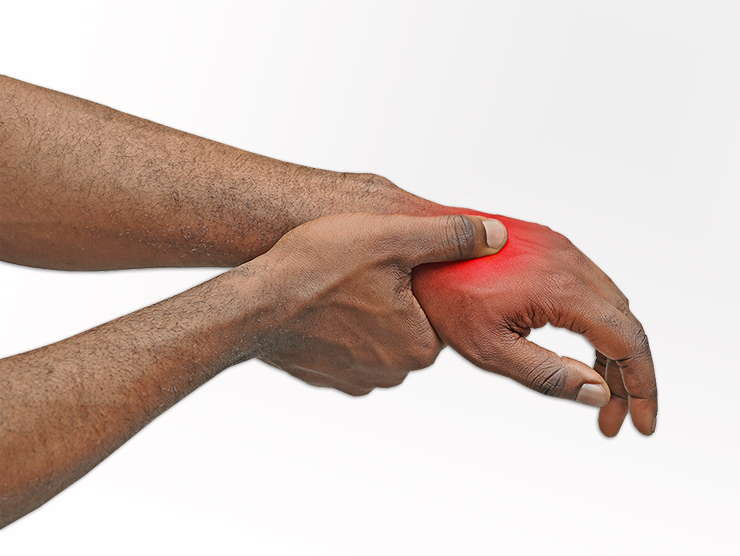
March 2, 2020 at 8:17 pm · drsahai · 0 comments
Top Reasons for Hand Pain
Hand pain is not uncommon. Accidents and underlying health conditions can cause pain. In most cases, the symptoms can be treated. When you know the cause, you can ease your pain. Many things can cause hand pain. Some hand conditions are more common than others.
Hand Pain from Arthritis
Arthritis is the leading cause of hand pain. Pain can be debilitating. The areas of the hand most affected by arthritis, such as:
- The base of the thumb
- The middle joint of fingers
- The end joint (closest to the tip)
Arthritis causes cartilage loss in the joints. Therefore, bones cannot move smoothly past each other. The less cartilage there is, the more pain and swelling occurs. Stiffness and bony nodules may also appear. The base of the thumb experiences the most aching feeling.
There are several types of arthritis. And osteoarthritis is the most common, causing progressive deterioration of joint cartilage. This develops with age and is common after an injury. Over time, your hand can become weaker. Daily activities will become difficult to do.
Treatment depends on how severe the disability is. Possible options include the following:
- Splints for fingers or wrist
- Heat therapy
- Physical therapy
- Anti-inflammatory medications
- Pain killers
- Surgery is an option if other treatments do not help.
Also, see Foods that Reduce RA Pain.
Carpal Tunnel Syndrome Pain
Carpal Tunnel Syndrome is a common hand condition. As a matter of fact, it’s one of the most common causes of hand pain. Pain occurs in the wrist and forearm and is worse at night. In addition to pain, you may also experience:
- Tingling
- Numbness
- Weakness
These sensations are often felt in the thumb, index, and middle fingers. It often makes it difficult to hold objects.
The median nerve passes through the carpal tunnel. It’s responsible for muscle impulses and sensations. Additionally, the carpal tunnel is a structure made from bone in your wrist. It is located near the base of your hand. Pain is caused when this nerve becomes pinched in this narrow space. Swelling to the wrist constricts this nerve causes loss of sensation.
Pain relief for carpal tunnel syndrome includes treatment, such as:
- Resting the hand
- Wrist splints
- Anti-inflammatory medication
- Steroid shots
- Physical therapy
Sometimes pain can persist for 6 months or more. In these cases, your doctor may advise surgery.
Fractures and Hand Pain
Fractures or breaks in the bone cause serious pain. In addition to severe pain, you may also have:
- Swelling
- Stiffness
- Loss of movement
For example, a fractured finger cannot be moved fully. It can appear swollen and maybe slightly shorter. Different types of fractures can affect your hand, such as:
Simple: the broken bone is stable and aligned
Complex: the break causes bone displacement, which is harder to treat
Comminuted: bones are broken in more than one place
Compound: broken bone pierces through the skin
Treatment will depend on the type of fracture. For simple fractures, casts and splints are used. More complicated breaks will need pins, wires, or plates for pain relief. Surgery is also used to set broken bones back into place.
Also see, Wrist Fractures We Bet You’ve Never Heard Of.
De Quervain’s Tendinitis
This condition causes pain in the thumb and forearm. And it can appear suddenly or develop gradually. It starts at the thumb and can travel through the forearm. The tendons at the base of the thumb become inflamed. This irritation causes pain. Additionally, overuse and repetitive actions are the cause of de Quervain’s. Those with this hand condition can experience pain when:
- Turning the wrist
- Making a fist
- Holding on to objects
This pain also occurs in new mothers. Holding the baby at awkward angles can tweak the wrist. Having a wrist fracture also increases the risk of de Quervain’s.
Possible hand pain treatment options for relieving pain, such as:
- Cortisone shots
- Anti-inflammatory medications
- Splint to immobilize wrist and thumb
Surgery may also be an option if the symptoms are severe or worsen. Although when conservative treatments fail, surgery is considered.
Trigger Finger Causes Hand Pain
The medical term for a trigger finger is stenosing tenosynovitis. So, what is a trigger finger?
The finger or thumb gets locked in a bent position. Pain can travel through the hand. However, the pain worsens when your finger or thumb is straightened.
The flexor tendons of the fingers control movement. When these become irritated, the tendons thicken. A thick tendon sheath develops around the tendon. Nodules can also form at the site, causing additional discomfort.
The thickened tendons cannot move as needed. They can become stuck when you bend or straighten fingers. It feels like a catching sensation when it locks in place. You also hear a pop when the tendon releases. It is not clear what causes the trigger finger. Certain conditions will increase the risk though such as:
- Gout
- Rheumatoid Arthritis
- Diabetes
Women are more likely to develop trigger fingers than men. It is also more common between the ages of 40 and 60.
Hand pain treatment involves pain medications and wearing a splint. Corticosteroid injections can also help alleviate pain and swelling. If other treatments fail, however, your doctor will recommend surgery.
Looking for a hand specialist? We’ve got you covered with a top hand doctor! Call us now at 888-409-8006.
